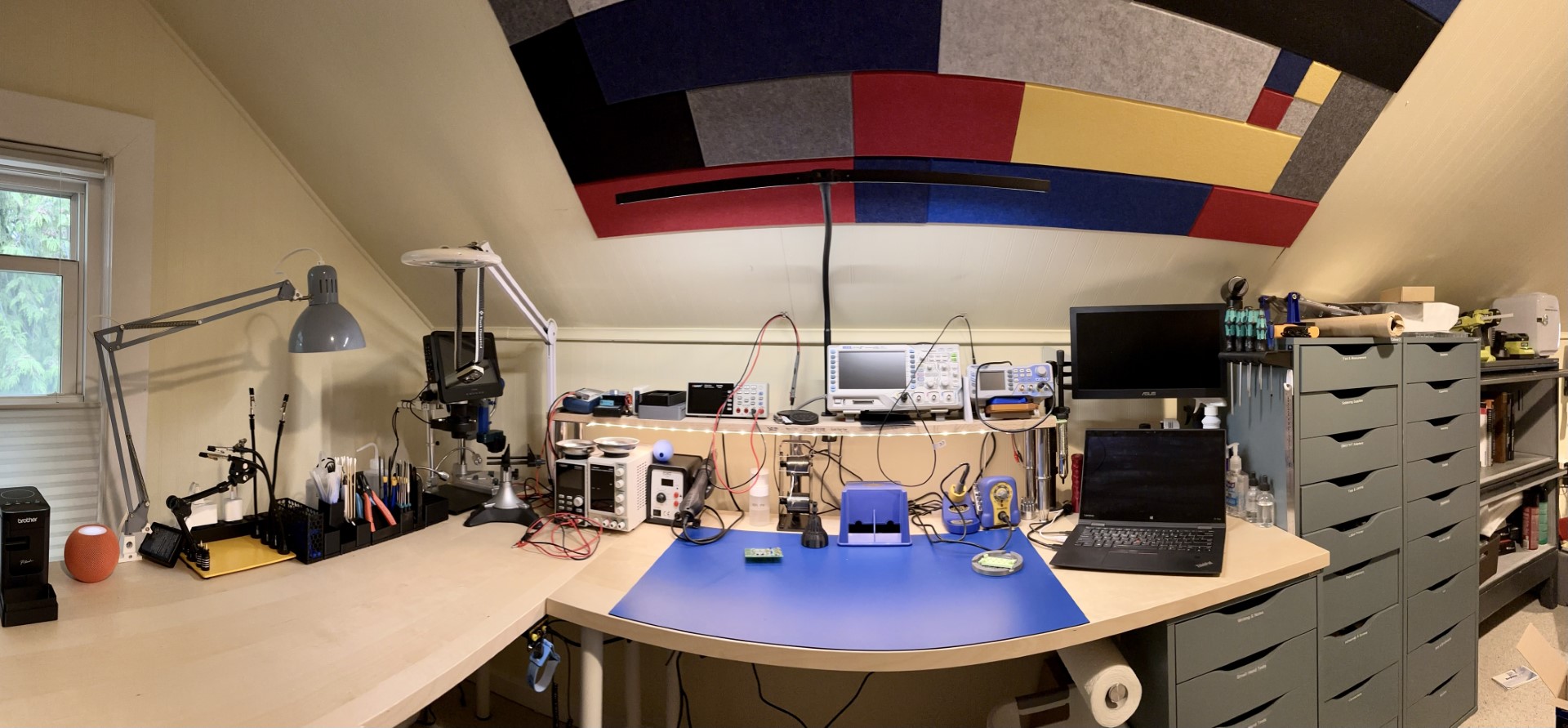Work Area
My Use Case
All of the information presented here is specific to my use case. I primarily work with electronics and various aspects of 3d printing, including a bunch of mechanical work that goes along with it. If your interests are elsewhere, this might not apply to you, but I hope you find some usefulness to inspire your own work area.
For my work area, I am primarily working in the attic of my 110yo 1,000sq' Seattle bungalow. This comes with both charms, but also unique challenges. For me, that's:
- This is directly under the roof, so the roof starts about 48" off the floor, and slopes up at something around 55 degrees to a 2' wide center section at the ridge. This makes for some space challenges when you're 6'3" tall as well.
- There isn't a huge amount of modern electrical service. The house, as a whole, has only 80A service, which means I have to pay attention to what I plug in and run simultaneously.
- It's carpeted. This is sub-optimal both from a stability perspective and for static discharge.
So, what have I done with the space? Here's a quick panorama:
I've tried to cram in everything I need, but I've had to make some (a lot) of compromises along the way. The work area is composed of IKEA birch veneer tabletops sitting on a combination of metal legs and a 5 drawer unit.
Rigidity Improvement
Currently, they aren't physically joined, but just butted up against one another. Occasionally, they start to separate, and this needs to be resolved. Likely some strapping with a few self-taping wood screws will be plenty to hold in place. and hold them flat at the same time.
Sitting on the main desk is a large Bertech ESD soldering mat, which I discuss more elsewhere. I then have a bodged together self composed of some red oak stair treads from my local lumber yard placed on shiny chrome-plated IKEA kitchen cabinet legs. These are adjustable and can handle a lot of weight. I specifically, wanted them to be able to be a reasonable height so that I could use the space under the shelf. There's also a small IKEA LED strip that provides a bit of extra light under the shelf.
Finally, I have a USB DisplayLink monitor from Asus that's mounted to an inexpensive Monoprice bracket which alows me to keep it above my laptop (a ThinkPad X1 Yoga that I've had forever and probably needs updating since getting Windows 11 on it was a chore).
Next to that is the drawer cabinets that I keep a bunch of parts in, and then past that some bookcases. The only cabinet worth discussing is the one directly under the desk. I've arranged the drawers for:
- Writing & Notes. This is pens, paper pads, 3x5 note cards, small scissors, and a calculator basically. A lot of pens.
- Small hand tools. These are extra sets of pliers, multi-bit screwdriver kits, security screwdriver kit, small metal roller.
- Medium hand tools. This is a soft-faced hammer, all my crimpers and cutters, etc, and large screw drivers.
- Measurement. Here is where I store my calipers, micrometers, levels, and other things I used regularly to measure something.
- Safety and Cleaning. This has gloves, masks, lint-free cleaning tools, etc.
All of these are designed to be in quick reach when working. Note that I also keep a roll of paper towels under the desk on a holder that is both taped and screwed to the drawers.
I'll discuss all the various things sitting on the bench elsewhere, primarily under tools.

Comments or Questions?
If you have any comments, questions, or topics you'd like to see covered, please feel free to either reach out to me on Mastodon (link below) or open an issue on Github.